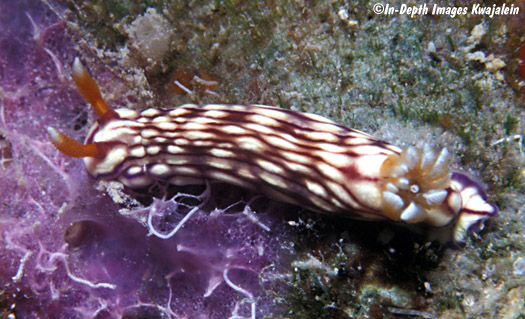
Hypselodoris whitei was not uncommon at Enewetak Atoll but was initially pretty hard to come by at Kwajalein until we started searching lagoon patches of Halimeda and other algae. They are typically found on lagoon interisland reefs in algae patches or under or exposed on rocks in 3 to 15 meters of water, but a few have been as deep as 35m at the bottom of the lagoon slope. Many were found on the pilings of Medren Island pier at Enewetak. The photo immediately below is from Enewetak. Often this species is found eating the purple sponge shown in a couple of the photos. 23 specimens measured ranged from 16 to 46mm in length. In the specimen immediately below, the round white circle with the central dot within the circlet of gills on the right side is the anus. What a place to dump one's wastes--right where it is trying to breathe. This species was first recorded in the Marshalls as Hypselodoris hilaris from Enewetak Atoll by Marcus & Burch (1965). The species has a rather interesting nomenclatural history and I think there is still some disagreement about the IDs of some specimens. Hypselodoris whitei was named by Adams & Reeve in an 1850 reference that I have not personally seen. However, referring to several of the Enewetak Atoll photos on the current page, Rudman mentions the “oblique purple lines on the foot which are present in the painting of this species in Adams & Reeve's (1850) original description.” In 1930 Risbec described specimens from New Caledonia as Chromodoris mouaci, and his figure clearly shows the crosshatched pattern seen in the first few photos below. C. mouaci is now considered a synonym of H. whitei. Rudman (1977) described Hypselodoris maridadilus, a similar animal from East Africa that showed primarily the longitudinal purple lines, although his written description mentions indistinct violet patches between the longitudinal lines forming a network. In the Sea Slug Forum, Rudman further differentiates H. maridadilus from H. whitei, noting the former has a pale yellow (rather than whitish) background color, straighter and distinctly purple lines on the dorsum with very indistinct cross connections the form the network, and solid orange rhinophores and gills (while H. whitei has white-tipped rhinophores and some white on the gills, particularly the inner surface and tips. I and Hans Bertsch added to the confusion by identifying specimens from Hawaii as H. maridadilus despite them having tiny white tips on the rhinophores and white inner gill surfaces Bertsch & Johnson (1979). More recently, Gosliner et al (2018) figures specimens with no crosshatching between the dorsal lines and white tips and inner surfaces to the rhinophores and gills as H. maridadilus and specimens like the first two below with distinct crosshatching as H. whitei. Marshall Islands specimens may or may not have distinct crosshatching between the dorsal lines and specimens of both types have been found paired and mating. It seems to me that the dorsal crosshatching and the white tips are variable characters. The white tipped rhinophores, for example, and quite evident on the Marshall Islands specimens but very tiny, almost non-existent, on specimens we have seen in Hawaii and Bali. The yellowish background is also variable (e.g., specimens from the Philippines). I’m inclined to say they are all the same species, in which case H. whitei has priority.

Of the two photos directly below, the upper is from Enewetak Atoll and the lower from Kwajalein Atoll. Not only is the mantle color different due to the crosshatching in the Enewetak specimen, but also what is visible of the foot coloration is quite different as well.
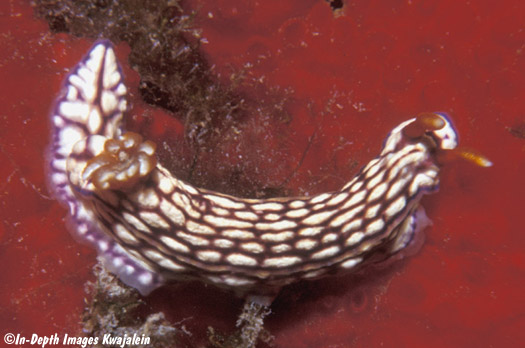
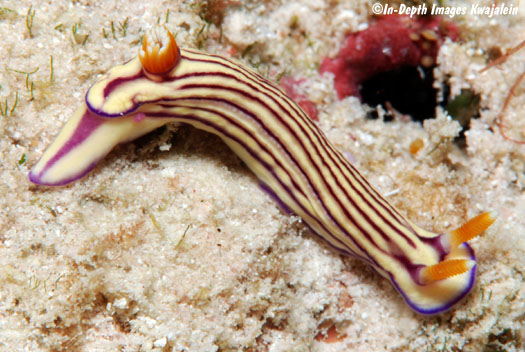
The pair below have been working on this purple sponge for some time. In the upper part of the photo to the left of the middle, you can see where the nudibranchs have eaten all the sponge tissue, leaving the naked spongin fibers. This is another shot from Enewetak.
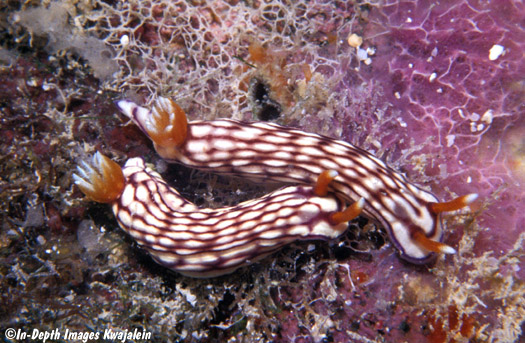
The next three photos show two specimens from Kwajalein Atoll. One of these has none of the crosshatching seen in all Enewetak specimens, and in the other this crosshatching is less pronounced than in those from Enewetak. These two were found as a pair at a depth of 10m in a lagoon Halimeda patch.
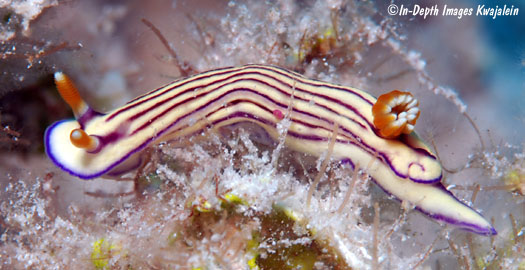
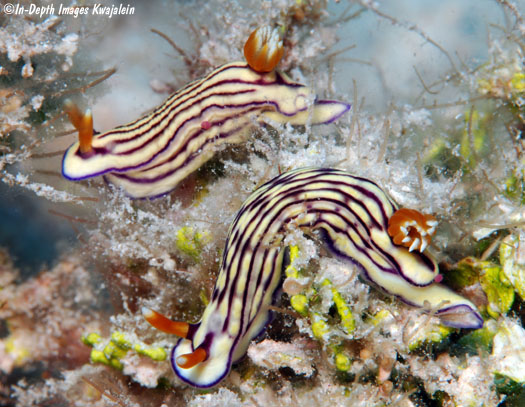
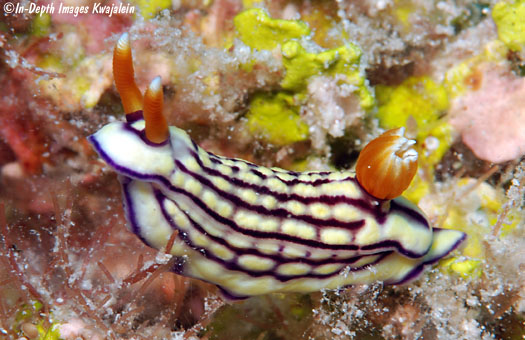
This Kwajalein specimen was found 15 September 2008.
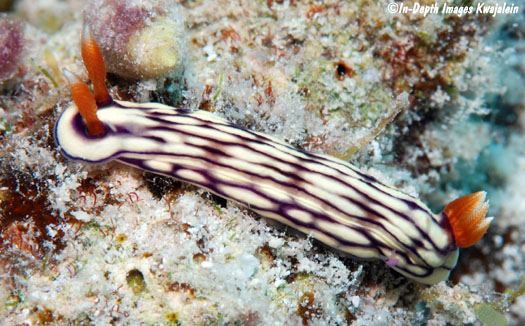
Below is another specimen from Kwajalein, found exposed at 8m on a lagoon pinnacle on 17 February 2009.

This one was in a loose carpet of algae on sand at a depth of about 32m on 24 December 2011.
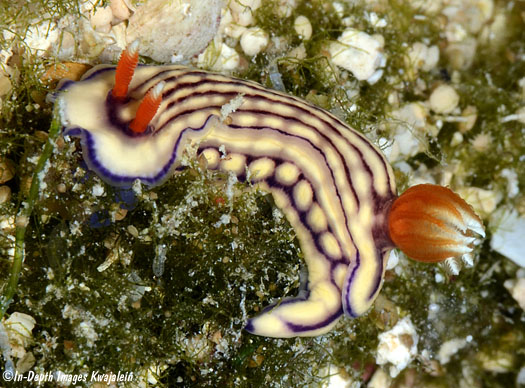
This pair was eating a colony of sponge in a lagoon algae patch at a depth of 35m on 28 May 2012.
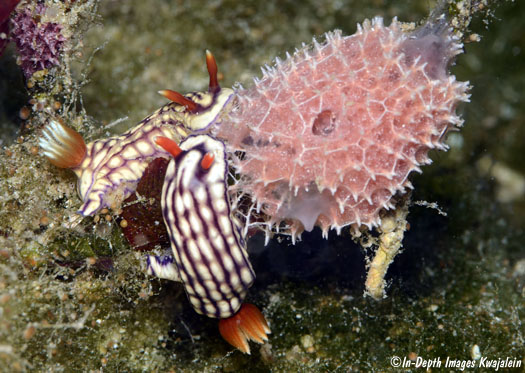
A small pink commensal copepod lives with the next individual, found on a Kwajalein lagoon reef on 23 February 2014.
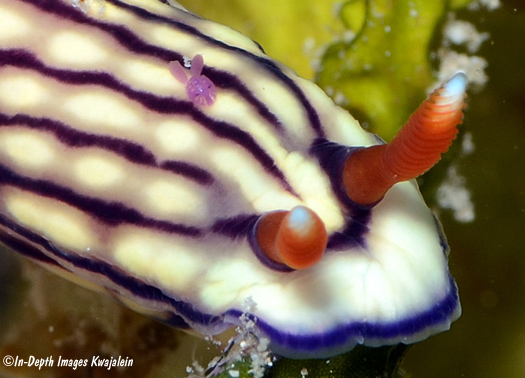
Created 21 December 2005
Updated 21 June 2025